Forget the cookie-cutter marketing strategies of the past; embracing user-generated content might be your hotel’s untapped goldmine.
In a world where over 1.8 billion digital photos are uploaded daily, the potency of user-generated content in the hospitality industry must be noticed. Primed and brimming with authenticity and trust, these nuggets of genuine interaction offer a priceless edge.
Harnessing the potential of user-generated content in hotel marketing is more than reposting a flattering review. It’s a strategic weapon. Let’s delve into the art of crafting compelling narratives with the photos, videos, and reviews your guests generate to amplify your hotel’s marketing prowess.
Harnessing User-Generated Content: A Comprehensive Guide
- Discover user-generated content and why it’s critical in the hotel industry.
- Learn how to implement user-generated content into your hotel’s marketing strategy.
Understanding User-Generated Content
User-generated content (UGC) entails any form of content that consumers create and post online about a brand or its products. This valuable content is generated voluntarily by a brand’s users, making it a robust and trustworthy way to aid marketing efforts within various industries, including the hotel industry.
Different types of user-generated content include customer reviews, photos and videos shared by consumers, social media posts, and blogs. Within the hotel industry, guests often create and share content regarding their experiences—such as their room, amenities, culinary delights, or even simply the hotel view.
UGC has become increasingly critical within the hotel industry. This form of content showcases real experiences from real people, providing a sense of authenticity and relatability that polished corporate marketing often lacks. As human beings, we value the experiences and opinions of others, making UGC influential in potential guests’ decision-making process. UGC ensures potential guests can access firsthand reviews and thoughts from individuals who have interacted with your hotel. In essence, existing guests become unpaid marketers for your establishment.
Steps to Implement User-Generated Content in Hotel Marketing
Step 1: Encourage guests to share their experiences.
Instigate a culture where guests are motivated to share their experiences on various platforms. Provide high-quality service and make your guests’ experience something worth sharing. Implement incentive schemes or promote hashtags related to your hotel to make it easier for guests to share content.
Creating a branded or specific hashtag on social media platforms like Instagram can amplify user-generated content (UGC). A unique hashtag, such as #(YourHotelName)Experience or #StayAt(HotelName), helps organise user-generated content and establishes a distinct online presence for your hotel. Encourage guests to include this hashtag in their posts, whether they’re sharing stunning sunset views from their room or delicious meals from your restaurant(s). By doing so, you not only foster a sense of community among your guests but also extend the reach of your hotel’s brand to a broader audience. Ensure this hashtag is promoted in your marketing materials, on-site signage, and social media profiles to maximise its visibility and impact.
Offering incentives or hosting competitions can also be a powerful way to encourage user-generated content. Consider running a contest where guests can submit their photos or stories related to their stay at your hotel, with the chance to win prizes such as complimentary stays, discounts on future bookings, or exclusive experiences. This incentivises guests to share their experiences and generates excitement and engagement around your brand. Additionally, showcasing UGC from such competitions on your social media channels or website can serve as authentic testimonials, inspiring others to share their own experiences and participate in future contests.
Step 2: Use social media platforms to collect and share user-generated content.
Social media platforms like Instagram, Facebook, and TikTok are teeming with user-generated content. As stated above, using hashtags makes it much easier to find all of the UGC. Use your own social media channels to repost and share user content. Consider seeking permission from the original posters before sharing their content.
Engage with users by liking, commenting, and sharing their posts, fostering community and connection. Curate a diverse range of UGC to highlight various aspects of the guest experience, from breathtaking views to memorable interactions.
Step 3: Incorporate user-generated content on your website and marketing materials.
User-generated content (UGC) is not confined to social media; it’s a potent resource for enriching your hotel’s website and marketing efforts. Showcase authentic guest experiences through photos, reviews, and videos on your website and social channels- bolstering credibility and trust with prospective guests.
Incorporating diverse UGC highlights various aspects of the guest experience while seeking permissions ensures ethical content use.
Utilise this genuine content in marketing collateral to create compelling messaging that resonates with your audience, ultimately driving bookings and enhancing your hotel’s online presence.
Step 4: Monitor and manage user-generated content.
It’s vital to monitor user-generated content regarding your hotel. This can provide valuable insights into guest satisfaction and areas of improvement.
As we have seen, user-generated content is a powerful marketing tool for hotels and accommodations, bridging customers’ experiences and potential online audiences. However, effective implementation of UCG calls for strategic action, careful monitoring, and responsiveness to user engagement.
The ripple effect of successful user-generated content utilisation provides a greater reach to potential guests, builds significant brand trust and loyalty, and opens doors for robust customer engagement. Implementing these will foster an environment where guests become strong brand advocates, amplifying your hotel’s presence to new audiences. For hotels, that’s a check-in worth considering.
The Impact of User-Generated Content on Hotel Marketing
- Increased brand authenticity and trust,
- Boosted SEO and online visibility,
- Enhanced customer engagement and loyalty.
Benefits of User-Generated Content in Hotel Marketing
When customers share their experience at your hotel on social media, they usher in a wave of believability that carries significant weight in the eyes of prospective customers. This sense of trust and authenticity helps increase customer conversion rates and direct bookings.
Increasing Brand Trust and Authenticity
UGC is raw and real by nature—the exact qualities that consumers seek when daydreaming about their next holiday. As more people share their remarkable experiences through genuine stories, photos, or videos, potential customers are more likely to trust your hotel and view it as a credible choice. UGC portrays your hotel as a beloved, reliable choice rather than a faceless entity.
Boosting SEO and Online Visibility
It also substantially affects your hotel’s search engine ranking. A constant inflow of fresh content—reviews, photos, videos, blog posts—aids in keeping your hotel’s digital presence dynamic and relevant. Search engines favour active websites, positioning them higher in search rankings. Beyond this, consider how UGC contributes to long-tail SEO, with satisfied customers often unintentionally including relevant keywords in their content.
Enhancing Customer Engagement and Loyalty
UGC attracts potential customers and strengthens the bond with your existing ones. By featuring and appreciating user-generated content on your platforms, you allow customers to feel seen and valued. This recognition often stirs a sense of loyalty, prompting future stays, repeated bookings, and more UGC.
Case Studies of Successful User-Generated Content Strategies in Hotel Marketing
Hyatt Hotels
Hyatt Hotels is a great example of gathering great UGC. The #InAHyattWorld campaign aimed to spotlight the company’s hospitality ethos by showcasing glimpses of life within the Hyatt community on social media. It proved to be very successful, with over 100,000 posts under that hashtag on Instagram. This shows just how useful developing and implementing a branded hashtag can be.
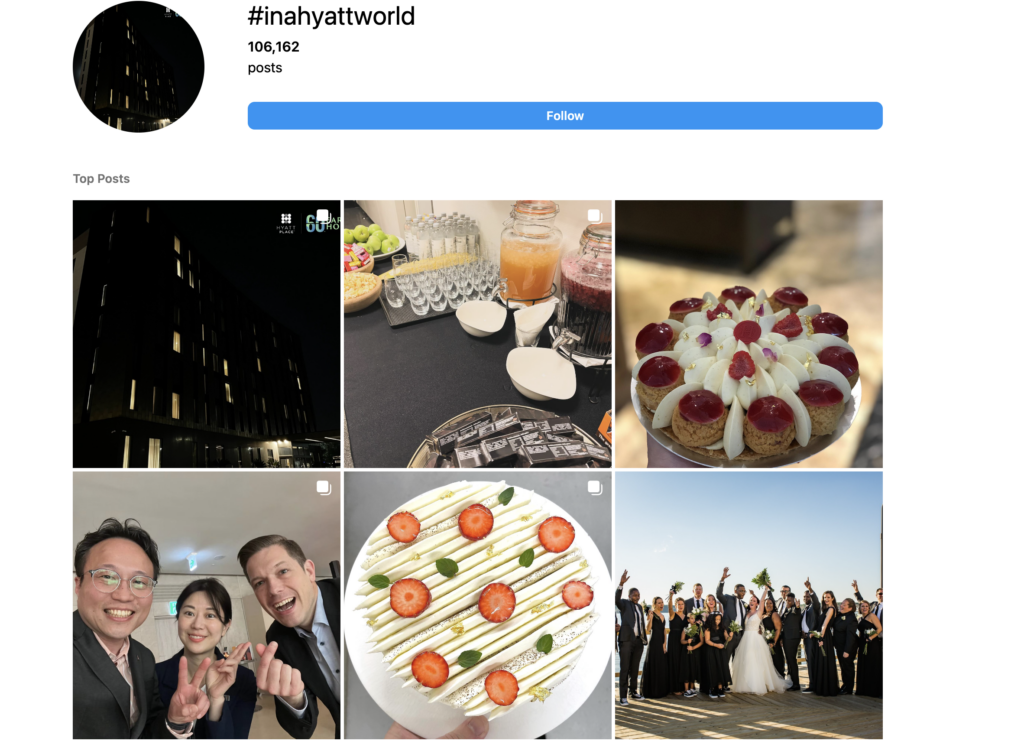
Atrium Hotels & Resorts
Atrium Hotels & Resorts hosted a social media contest last summer asking guests and previous guests to submit a photo or video of their stay at one of its hotels. This is a great way to incentivise people to post, creating a buzz about the hotel brand. The hotel offered three very generous rewards, including a complimentary stay at one of their hotels. Not only does this campaign aid in gathering a massive amount of UGC, but it also gives the opportunity to gain new followers, expand its reach, and maximise engagement.
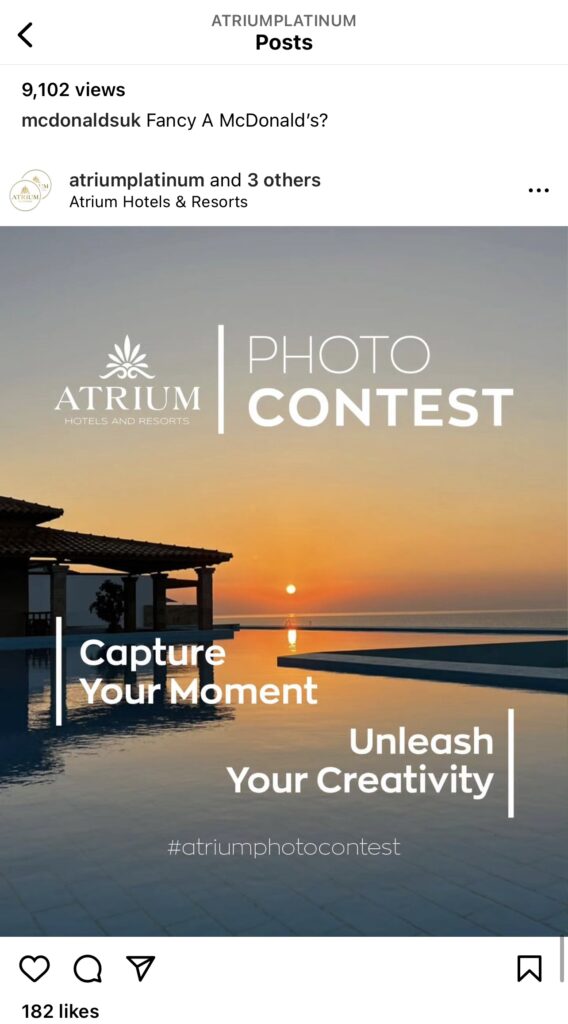
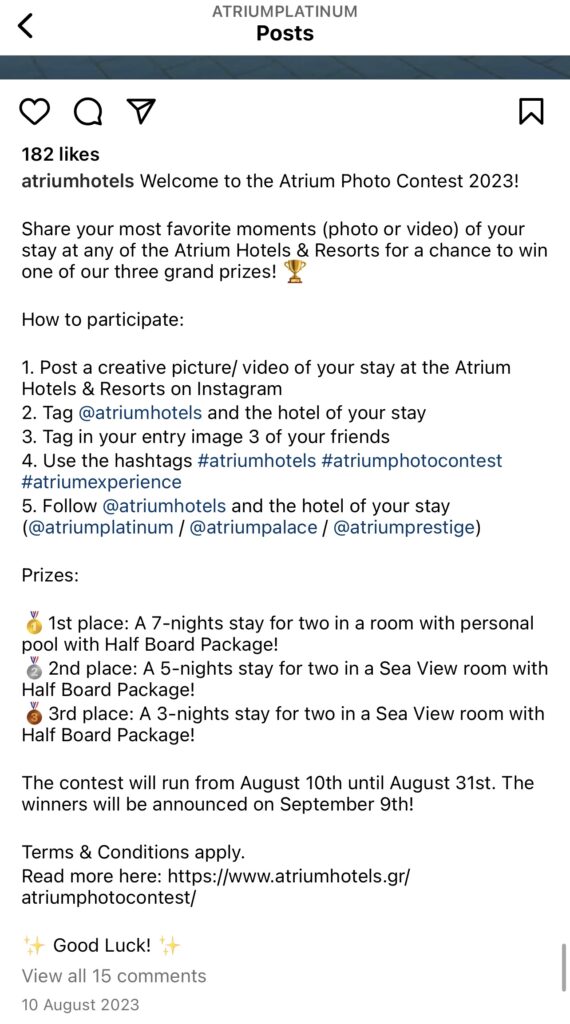
Overcoming Challenges in Harnessing User-Generated Content
- Identifying common mishaps when leveraging user-generated content
- Hands-on solutions for bypassing those challenges
- Ensuring a smooth flow of valuable, authentic user content
Common Challenges in Implementing User-Generated Content
Many hotels discover uncertainties associated with the quality of user-generated content. It’s natural to be concerned about inconsistent quality, as users have different photography skills and writing expertise levels.
In addition to that, there are the complications of copyright issues. When users share images or written content publicly, it doesn’t necessarily mean hotels have the rights to utilise that content for marketing purposes without specific permissions from the users.
Lastly, welcoming user content inherently includes the risk of receiving negative reviews or feedback. Negative experiences shared through user-generated content can deter prospective guests, negatively impacting your brand image and revenue.
The Issue with Content Quality
The internet’s infinite reach means that everyone can contribute content. But what if the content quality is subpar? A poorly shot image or poorly written review can reflect badly on your brand. And with user-generated content, you have little control over what is shared.
Content shared by guests, whether it’s photos, videos, or reviews, directly influences how potential guests perceive your hotel. A poorly shot image or a badly written review can undermine the image of professionalism and quality you’ve worked hard to establish. Inconsistent or low-quality content can detract from the overall guest experience and deter potential customers from choosing your hotel.
For instance, many travellers tend to submit photos and written reviews on Tripadvisor, so it is not uncommon to see photos varying in quality. Hotel guests could all submit a photo of their hotel room, but the quality of each photo will vary significantly depending on their photography skills, what device they’re taking the photos on, whether it’s well-lit, etc.
Example: photo submissions of Novotel Budapest Danube on Tripadvisor
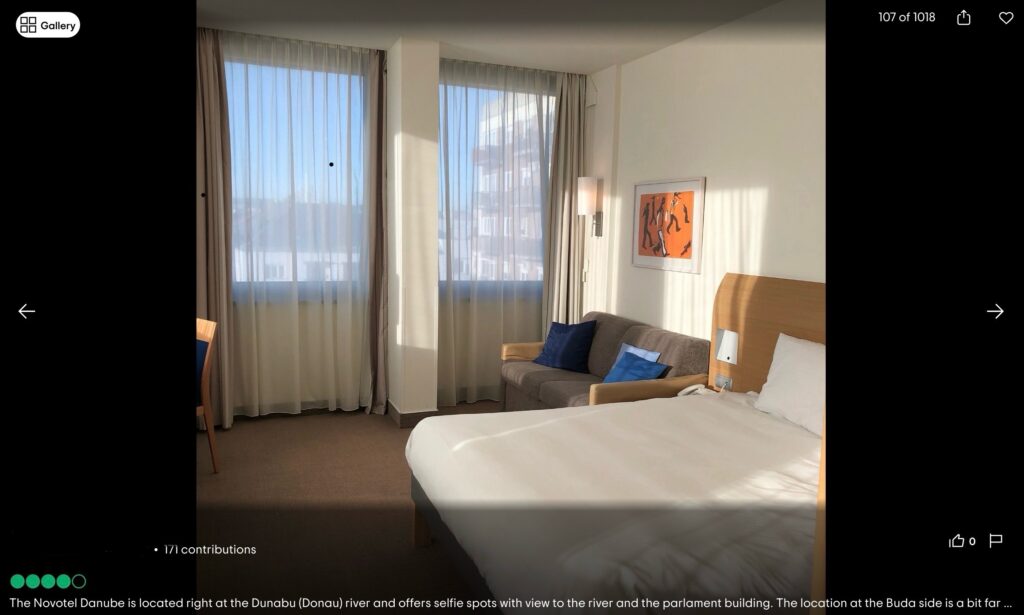
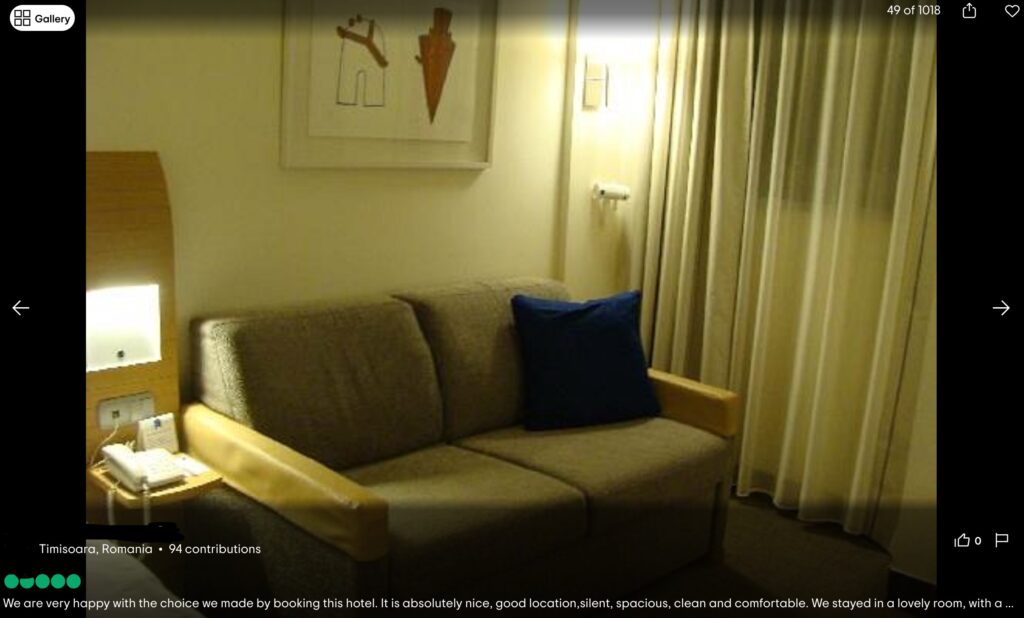
The first photo shows a well lit, good quality photo of the bedroom/living area. This makes the hotel room look bright, airy and inviting, whereas the second photo of the bedroom/living area, submitted by a different guest, isn’t well lit affecting the quality of the image. This can significantly change consumer perception of the hotel overall.
One of the inherent challenges of user-generated content is the lack of control over what is shared. Unlike professionally curated content, which can be carefully crafted to align with your brand’s messaging and standards, UGC is created independently by guests, leaving you with limited influence over its quality and relevance. This lack of control can be unsettling for hotel owners who value consistency and precision in their marketing efforts.
Subpar content can also lead to unrealistic expectations among potential guests. Suppose UGC portrays your hotel in a less flattering light due to poor quality or misrepresentation. In that case, it can create discrepancies between guests’ expectations and the actual experience they encounter upon arrival. Managing these expectations becomes challenging when UGC fails to reflect your hotel’s true essence accurately.
Navigating Around Copyright Issues
Another issue with user-generated content is copyright issues. You cannot simply use the images or content shared by users without their explicit permission, which could lead to legal complications.
When users create content, they automatically own their intellectual property rights. Using their photos, videos, or written materials without permission could infringe on their rights and lead to legal issues for your hotel. Obtaining permission demonstrates respect for the creators’ ownership of their work and helps protect your hotel from potential legal liabilities.
Requesting permission before sharing user-generated content also fosters trust and transparency with your audience. It shows that you value your guests’ contributions and seek their consent before featuring their content in your marketing materials or on your digital platforms. This proactive approach can enhance your hotel’s reputation and strengthen relationships with current and potential guests.
Dealing with Negative Reviews
Negative reviews can impact your reputation and, ultimately, your bottom line. In today’s digital age, where online reviews heavily influence consumer decisions, even a single negative review can have far-reaching consequences for your business. Research shows that most consumers read reviews before making a purchase decision, and negative reviews can significantly impact their perception of your hotel’s quality and reliability.
Solutions to Overcome These Challenges
Nevertheless, there are practical solutions to these challenges…
Setting Submission Guidelines
While you may have little control over the quality of user-generated content on platforms like Tripadvisor, there are strategies you can employ to mitigate the impact of subpar content on your brand. Encourage guests to share their experiences by providing guidelines for creating high-quality content, such as tips for taking better photos or writing helpful reviews. You could also set guidelines for a photo contest, like the above example from Atrium Hotels and Resorts. This is a great way to gather the best UGC because people want to win. By actively curating and promoting the best user-generated content, you can maintain a positive online reputation and ensure consistency in the portrayal of your hotel across digital platforms.
Obtaining Necessary Permissions
When sharing user-generated content, obtaining the necessary permissions is of utmost importance.
When seeking permission to use user-generated content, it’s essential to provide a worded request outlining its intended use and any associated terms or conditions. This request should be sent directly to the content creator through direct messaging on social media platforms, email, etc. Explain why you’re interested in featuring their content and how it aligns with your hotel’s marketing objectives.
Once you have their permission, it’s essential to document the details of the agreement for future reference. Keep records of all communications about obtaining permissions, including any written consent or agreements reached with the content creator. This documentation can serve as proof of permission in case of any disputes or legal issues.
Managing Negative Reviews Effectively
Negative feedback isn’t necessarily bad. The key is tackling negative reviews gracefully and being ready to make amends. Here’s what you can do:
- Prompt response: Responding to negative reviews promptly and proactively is essential for mitigating their impact. Acknowledge the guest’s concerns and apologise for any shortcomings they experienced during their stay. Demonstrating empathy and a willingness to address the issues raised can go a long way in appeasing disgruntled guests and showing potential customers that you take feedback seriously.
- Take the conversation offline: While responding to negative reviews publicly to demonstrate accountability and transparency is essential, aim to take the conversation offline as soon as possible. Provide contact information or invite the guest to contact you directly to discuss their concerns further. This lets you address the issue privately and work towards a resolution without airing potentially sensitive details in a public forum.
- Learn from Feedback: Negative reviews, while challenging to receive, can also provide valuable insights into areas for improvement. Pay attention to recurring themes or common complaints raised in negative reviews and use this feedback to identify opportunities to enhance the guest experience. Whether it’s addressing issues with cleanliness, improving customer service training, or updating facilities, viewing negative reviews as constructive criticism can help you make meaningful improvements to your hotel operations.
- Encourage Positive Reviews: While you can’t prevent negative reviews entirely, you can offset their impact by actively encouraging satisfied guests to leave positive reviews. Implement post-stay email surveys or incentives for leaving reviews to increase the likelihood of receiving positive feedback. Building a portfolio of positive reviews can help counterbalance the occasional negative review and showcase your hotel’s strengths to potential guests.
To conclude…
User-generated content is powerful, transforming guests into brand champions and their stories into trust-building narratives. With the right platform, it’s an efficient, cost-effective approach to marketing, offering a sharper edge in a highly competitive industry.
Frequent review and tweaking of your user-generated content strategies can ensure their effectiveness. Look closely at your content, considering guest feedback and overall engagement, and optimise where needed.
User-generated content is as dynamic as it is rewarding. Experimentation and adaptability can help you ride this wave successfully.
Remember the value here: user-generated content is authentic and influential – a key advantage in decision-making for potential guests. Additionally, it frees up time and resources, allowing you to focus on delivering exceptional hotel experiences.
It’s time to seize the momentum. Plan a strategy that encourages guests to share experiences and highlights remarkable moments on your website or social media platforms.
Make the most of it. Turn your guests into your brand’s biggest cheerleaders.
Here’s more about content marketing strategies within the travel and hospitality industry.
Don’t have the time to keep up with marketing demand? Outsourcing your marketing to us frees up valuable time and resources. We handle everything from strategy to execution, so you can put your time and energy into providing exceptional guest experiences. Get in touch!



